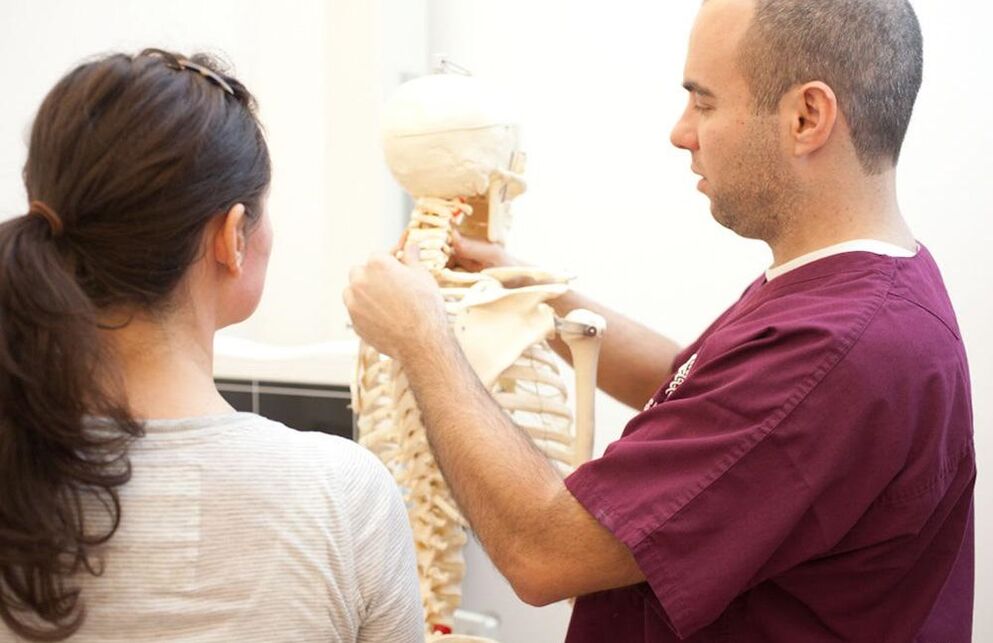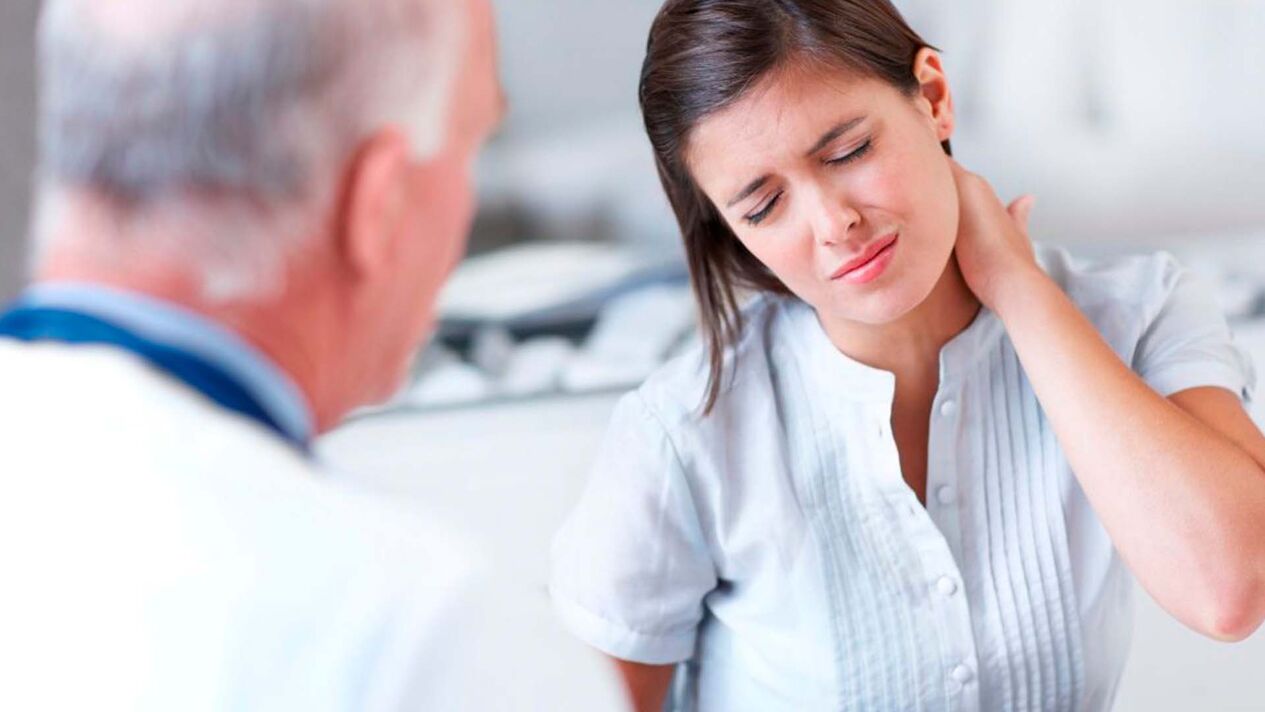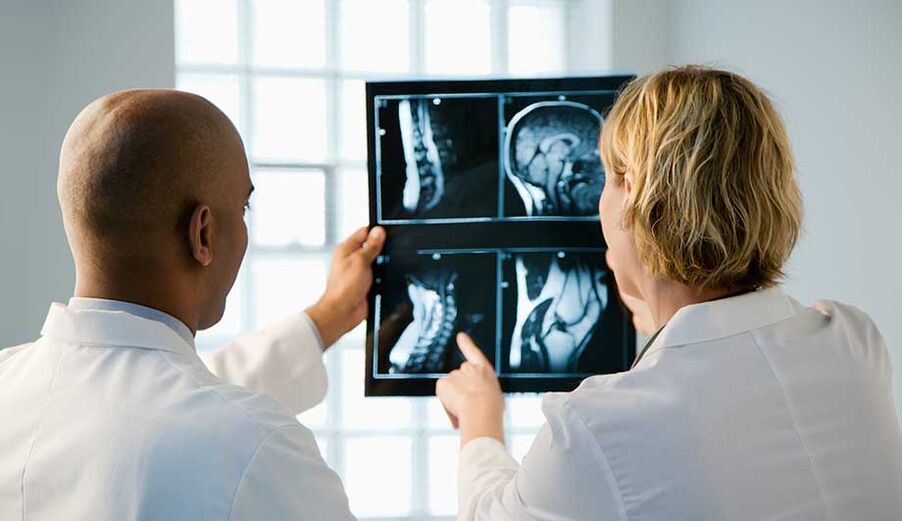
The article looks at the symptoms and treatment of osteochondrosis of the cervical spine. What is this pathology? How is it expressed?
Osteochondrosis is practically the most common disease in the world. Many people after 30 years suffer from this pathology in various forms. There is also a tendency to rejuvenate the disease, that is, to lower the age limit. This may be because there are more and more people today who mainly have a job in which a person spends most of their time sitting and leading a sedentary lifestyle. By the way, such a disease is dangerous, and everyone needs to know what cervical osteochondrosis is, what it looks like, how to treat it, and how to identify its symptoms.

The main causes of the onset of the disease
A person is designed in such a way that the vertical arrangement of the spine can cause the vertebrae to become more and more squeezed over time, as a result of which bone and cartilage tissue are gradually broken down and deformed.
The spine always begins with the cervical spine, which consists of seven vertebrae. This is a particularly vulnerable part of it as there is increased mobility in this area. Such a disease of the cervical spine is mainly reflected in the intervertebral discs themselves, because they are a weak point in the spine.
The frequency of degenerative disc disease of the cervicothoracic region is favored by factors such as the small size of the vertebrae and the relative weakness of the neck muscles. In addition, poor blood flow to the cartilage tissue affects the developing ailment. What does it all mean?
Accordingly, the development of this disease seems to be a long and complex process, in which it is very difficult to identify the cause. Although a connection between a sedentary lifestyle and osteochondrosis of the cervical spine has been established, a similar condition is often found in trained people, especially athletes, due to the increased stress on the cervical spine. You lift various weights (barbells, weights), which leads to deformation of the intervertebral discs. So everything needs a measure.

In the elderly and the elderly, such a breakdown of the vertebral structures is, as a rule, an inevitable process, which in turn is associated with the aging of the body and the weakness of its defenses. But there can also be a pathological form of osteochondrosis of the cervical spine, the symptoms of which appear due to internal or external negative factors. These include:
- various back injuries;
- Rachiocampsis;
- heavy weight;
- wrong posture;
- Hypodynamia;
- Hard physical work;
- disturbed metabolic processes;
- Hypothermia;
- Overwork, stress;
- Infectious diseases;
- Inheritance;
- congenital pathologies or peculiarities of the body structure.
Stages of osteochondrosis of the cervical spine
The pathology has four stages. Sometimes, according to general analysis, it is quite difficult to determine what stage of the disease a patient is in, since the extent of bone tissue breakdown most often does not match the symptoms observed in the patient.
The first stage of the disease
At this stage, destructive actions are already taking place in the vertebrae. But the symptoms of cervical osteochondrosis are not yet very pronounced. People may not notice or associate these signs with a spinal disorder, they call it stress or mundane overwork.
The second stage of the disease
As mentioned earlier, the symptoms and treatment for cervical osteochondrosis are closely related.
At this stage, a noticeable thinning of the disk occurs and cracks appear on its surface. Symptoms of cervical osteochondrosis at this stage are observed with constant pain, numbness of the face and weakness.

Third section
What are the symptoms of osteochondrosis of the cervical spine at this stage? Herniated discs occur, neck vessels and muscles are affected. The person experiences dizziness and pain in the back of the head.
The fourth stage of the disease
With osteochondrosis of the cervical spine, osteophytes are common - the proliferation of bone tissue that protects the vertebrae from stress, causing nerve pinching. This is characterized by stiffness of movement and damage to adjacent joints.
Signs of cervical osteochondrosis
The main symptoms of osteochondrosis of the cervical spine are:
- Sharp pains in the shoulders and neck.
- Weakening of the muscles.
- Increased sweating.
- Incoordination.
- Numbness in the hands.
- Dizziness.
- Hypertension.
- Decreased hearing and eyesight.
- Headache.
These common symptoms of cervical spine osteochondrosis can manifest themselves at any stage of the disease. In most cases, only a few characters from this list will be visible, while the rest may be missing entirely. The patient who meets them for the first time practically does not diagnose cervical osteochondrosis. In this case, he can turn to various doctors - cardiologists, neuropathologists, therapists, surgeons. And at the end of the day, a reliable diagnosis can be made with a considerable delay.
Danger of pathology
Not everyone knows the symptoms and treatment of cervical osteochondrosis.
The first symptoms of osteochondrosis can appear after 20 years, while the pain and discomfort are mild. As a result, many people choose to wait hoping the symptoms will pass, postpone seeing the doctor and not start treatment. Symptoms in the early stages of osteochondrosis may really go away on their own, but this disease will not go away from a person. If prevention and therapy are not carried out, osteochondrosis begins to develop further, which can become dangerous for human health.

What are the dangers of osteochondrosis of the cervical spine?
In the first stage, symptoms are mild, so most people prefer not to take this disease seriously. However, if the patient does not start treatment at the beginning of development, it can lead to dangerous, serious complications. The consequences of a neglected phase are a state in which a person cannot perform their functions. This can often be accompanied by lesions in adjacent departments. Such abandoned osteochondrosis leads to very dangerous consequences, followed by disability.
In addition, the following can develop:
- Protrusion of the intervertebral discs;
- Protrusions and intervertebral hernias;
- Loss of discs;
- Lumbago or sciatica;
- Spinoses of the vertebral canal.
In special cases, the diseases listed above are forced to undergo surgery, and the consequence of an advanced stage is disability.
The problems listed above are characteristic of osteochondrosis of the cervical spine.
Complications of the disease
The danger of the disease lies in the fact that the neck region is connected to the vessels that supply the brain with blood. The consequences of the disease cervical osteochondrosis are sleep disorders, migraines, visual disturbances, dizziness. If the disease is advanced, the symptoms listed become more noticeable. With cervical osteochondrosis, there is a possibility of accompanying problems:

- high or low blood pressure and vascular dystonia;
- Thyroid disease;
- vestibular disorders;
- High blood pressure or hypotension;
- Stroke;
- Epicondylitis;
- humeroscapular periarthrosis.
Diagnostics of the pathology of the cervical spine
The symptoms and treatment of osteochondrosis of the cervical spine are of interest to many.
For a correct diagnosis, you need to consult a therapist. He will refer to other specialists - neurologists, vertebrologists, orthopedists.
To diagnose the disease, the following types of studies are attached:
- CT scan;
- Roentgen;
- MRI;
- Doppler scanning.
X-rays show the presence of growths, dislocations of the vertebrae, salt deposits and osteophytes, intervertebral disc seals. With the help of computed tomography you can get a fairly comprehensive picture of the organs, in this case the cervical spine. It will make it possible to describe the stage of the pathological process, as well as the type of nerve clamp, the height of the intervertebral discs and the structure of the osteophytes. Magnetic resonance tomography provides an even more detailed picture of the structure of the spine. An ultrasound scan can help determine how the blood flow in the large vessels in the neck has changed due to the disease.

Treatment of this disease
Symptoms and treatment of osteochondrosis of the cervical spine are related.
In order for a person to be able to withstand an illness, medicine develops many methods. There are also therapies that you can use at home. However, this procedure is tedious and full recovery is unlikely, especially in old age. But it is also worth noting that at any stage of the disease it is possible to stop and slow down pathological processes in the spine.
In the first stages of the disease, treatment methods for osteochondrosis of the cervical spine are mostly conservative. Several methods can be used for therapy:
- Physical therapy;
- Medication;
- Massage;
- Physical therapy;
- special devices for fixing the spine.
If such a disease has passed to an extreme stage, while the osteochondral structure of the spine is destroyed, then surgical intervention should be performed to cure osteochondrosis of the neck.
Drugs for the therapy of pathology
Necessary drugs for the treatment of osteochondrosis of the cervical spine:
- Analgesics;
- Vitamins;
- Chondroprotectors;
- anti-inflammatory drugs;
- antispasmodic.
When acute pain syndrome associated with osteochondrosis occurs, the most important task is to get rid of it. In such cases, oral pain relievers are used, but if the effects are not noticeable, novocaine blockade can be used.
Symptoms and treatment of osteochondrosis of the cervical spine often remain controversial for many.
Antispasmodics are often taken. Muscle relaxants are most effective in treating osteochondrosis. As pain relievers and anti-inflammatory drugs, the patient can use ointments that contain non-steroidal drugs.
If there are signs of impaired blood supply to the brain and vertebral artery syndrome, it is necessary to use drugs that eliminate their unpleasant manifestations - drugs that lower blood pressure and nootropics.
Symptoms and treatment of osteochondrosis of the cervical spine are no longer a secret.

Physical therapy exercises
Physiotherapy is the easiest and most accessible way of therapy and prevention of cervical osteochondrosis and is also very effective. Physiotherapy can also be done at home. In cervical osteochondrosis, the saturation of the classes does not play a major role, only their regularity. Physical education primarily serves to strengthen the neck muscles, the task of which is to compensate for the lack of functionality of the spine and to support weakened vertebrae. Treatment of osteochondrosis of the cervical spine should be done regularly.
Daily exercise is necessary to strengthen the muscles. Such exercises can be very simple, including turning and tilting your head in different directions, and quite complex, in which hands support the muscles of the neck. They can be done both at home and at work. For example, if you have to work sitting down all the time, it is very useful to do different exercises every hour while sitting at a table and a monitor. But this is necessary only if there is no exacerbation of the disease and no pain syndrome. Otherwise, the same exercises can only make the condition worse.
It is also effective in treating osteochondrosis of the cervical spine to strengthen the muscles of the shoulder girdle, for example, use light dumbbells in regular exercise. However, lifting weights such as kettlebells or barbells is contraindicated. Regular swimming activities can be helpful as they take the strain off the spine.
We studied the symptoms and treatment of osteochondrosis of the cervical spine.
















































